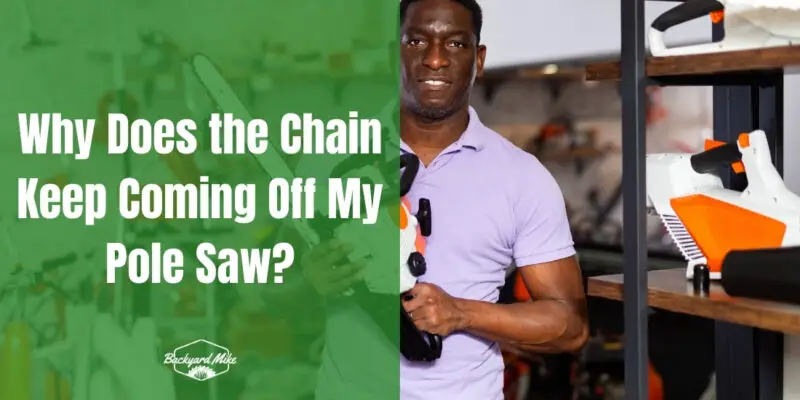Guarantee your pole saw's chain tension is properly adjusted to prevent slippage and detachment, checking it regularly, especially during prolonged use. Keep an eye out for worn or damaged components, like the chain and guide bar, while maintaining them according to the manufacturer's guidelines. Also, inspect if the chain size matches your saw specifications, and examine the tensioner for any malfunctions. Proper maintenance and correct parts alignment are key to keeping the chain secure and efficient. Discover more insights ahead.
Key Takeaways
- Incorrect chain tension can cause detachment; ensure proper adjustment to prevent slippage and maintain safety.
- Worn or damaged components, like the chain or guide bar, may lead to instability and detachment.
- Using the wrong chain size or improper attachment can result in misalignment and chain coming off.
- Tensioner malfunctions, such as stripped screws, can affect tension control, causing the chain to detach.
- Lack of regular maintenance, like cleaning and lubrication, can lead to performance issues and chain detachment.
Understanding Chain Tension Issues
When it comes to understanding chain tension issues, recognizing the importance of proper chain tension is crucial for your pole saw's performance. Regular tension monitoring helps you maintain peak functionality, guaranteeing your chain doesn't slip off. Chain slack can lead to dangerous kickbacks or even cause the chain to fly off, creating safety hazards. Broken tensioners can also result in a loss of chain tension control, exacerbating these risks. Adjustments should be made frequently due to heat expansion during operation. Locate the tension adjustment points, usually found on the side cover. Stop the motor, loosen the cover screw, and turn the tensioning screw clockwise to tighten. Verify there's no chain slack on the bar's underside when cold. By staying proactive about tension monitoring, you'll keep your saw efficient and safe, fostering a sense of reliability and belonging in your tool's performance.
Identifying Worn or Damaged Components
A well-maintained pole saw guarantees efficient and safe operation, and identifying worn or damaged components is a key part of this maintenance.
Start by checking for chain wear, which can lead to improper fit and chain detachment. Confirm the chain size and type match your saw to prevent misalignment. Examine for damage like cracks, as they compromise its holding capacity. Regularly clean the chain to avoid debris accumulation, which affects performance. Verify that the guide bar's rails and gutter alignment are intact to maintain chain alignment and lubrication frequency. Proper lubrication reduces friction and wear on the chain, so ensure your oiler system is functioning correctly. Electric sharpeners are efficient for frequent maintenance, offering fast and precise sharpening.
Inspect the oiler system for clogs or malfunction, as insufficient lubrication increases friction.
Finally, check sprockets, bearings, and fasteners for wear or damage to confirm consistent chain operation.
Recognizing User Errors
To keep your pole saw running smoothly and safely, it's vital to recognize common user errors that might cause the chain to come off.
Operator negligence often leads to these issues, but with awareness, you can avoid them.
Awareness can prevent operator negligence from causing common pole saw chain issues.
Here's a list of common mistakes to watch for:
- Incorrect chain tensioning: Verify the chain isn't too tight or too loose, as both conditions can lead to it falling off during use.
- Failure to check chain tension: Regularly inspect and adjust the tension, especially during prolonged use. If the chain completely falls off, use the provided tool to loosen the chain before attempting to reattach it.
- Improper chain size: Use the correct chain size for your pole saw to prevent misfit and instability.
- Neglecting proper attachment methods: Always use the correct tools and methods to reattach the chain, avoiding damage and further issues. A good habit is to maintain your equipment by following the manufacturer's guidelines for optimal performance.
Addressing Tensioner Malfunctions
Although it might seem intimidating at first, addressing tensioner malfunctions on your pole saw is straightforward if you follow a few key steps.
Start with a thorough tensioner inspection by removing the chain cover. Look for stripped or loose screws, which might cause the tensioner to move freely and affect chain control. Regular tensioner use can lead to wear, so keep an eye out for debris accumulation that may impede function. Additionally, frequent maintenance is required for optimal performance of the pole pruner, as users have noted issues with oiling problems that can affect the chain's tension.
If you find damage, consult your user manual to verify you're using the correct part number for replacement procedures. Don't forget to clean around the tensioner to maintain its functionality.
Simple fixes, like adding a washer, can improve performance temporarily until a replacement is secured.
Evaluating Bar and Chain Wear
After confirming your tensioner is functioning correctly, it's important to evaluate the wear on your pole saw's bar and chain.
Bar wear and chain wear can greatly impact performance and safety. Here's how you can check for signs of wear:
- Groove Splay: Inspect the bar for splayed grooves, as this affects cutting accuracy.
- Chain Fit: Look for excessive side-to-side movement; it suggests worn bar grooves.
- Sharpness: A dull chain needs frequent sharpening, indicating chain wear.
- Drive Link Wear: Check if drive links are worn, causing the chain to ride too high.
Regular evaluations guarantee your pole saw operates efficiently and safely, keeping you part of a knowledgeable community that values maintenance. Remember to flip the bar over after every 10 sharpenings to even out wear, ensuring long-term reliability and performance.
Implementing Safety and Maintenance Practices
When you're working with a pole saw, always wear essential safety gear like gloves, goggles, and hearing protection to minimize the risk of injury. Regular chain maintenance is vital; guarantee proper tensioning, cleaning, and lubrication to keep the chain running smoothly and prevent it from coming off. Additionally, it's important to clean the oil guide groove in the saw rail to ensure proper lubrication and prevent damage to the chain.
Essential Safety Gear Usage
Here's a quick checklist for your safety:
- Eye Protection: Use safety goggles.
- Hearing Protection: Wear ear defenders.
- Headgear: Don a hard hat.
- Hand Protection: Use sturdy work gloves.
Before operating, ensure that the pole adjusts properly and that all adjustment collars are secure. These precautions help you belong to a community of safe, responsible pole saw operators.
Regular Chain Maintenance Practices
Regular chain maintenance is essential for guaranteeing peak performance and safety while using your pole saw.
Start by regularly inspecting the chain and bar for wear or damage, confirming proper alignment. Check that the chain fits snugly in the bar's groove and matches the specifications stated on the bar. Worn sprockets or bars should be replaced to prevent further damage. Implement chain cleaning by removing debris from the chain groove and oil holes with a soft brush. This prevents obstruction and guarantees effective lubrication.
Use appropriate lubrication techniques to prolong the life of your chain and bar, applying chain oil continuously during operation.
Adjust the chain tension for 2-3 mm of play, preventing it from sagging or being too tight.
Regularly inspect sprockets and bars for uneven wear to maintain ideal functionality.
Choosing the Correct Chain for Your Pole Saw
Choosing the correct chain for your pole saw is essential for ideal performance and safety. You need to verify chain compatibility by considering several key factors.
Selecting the right chain ensures optimal pole saw performance and safety by verifying key compatibility factors.
First, focus on pitch selection, which determines the distance between links and must match your saw's specifications. Chain tension is crucial for safe operation, so ensure it is properly adjusted to prevent the chain from coming off.
Here's a quick guide to help you:
- Cutter Styles: Choose between full chisel, semi-chisel, and chipper based on your cutting needs.
- Chain Pitch: Verify the pitch, like 1/4" or .325", matches your pole saw.
- Chain Gauge: Match the gauge, such as .050", with your guide bar for proper fit.
- Drive Links: Count them to verify the chain length suits your saw.
Inspecting and Replacing Faulty Parts
When your pole saw's chain keeps coming off, it's crucial to inspect and potentially replace faulty parts to guarantee safe and efficient operation.
Start with a thorough component inspection checklist. Check the chain tension regularly, ensuring it's neither too loose nor too tight. Inspect for worn or damaged chain components, like broken links or stretched chains, which may require chain replacement techniques to maintain safety. Chain oil will seep slightly when not in use, so it's important to monitor oil levels and refill the reservoir as needed to ensure smooth operation.
Examine the guide bar for wear, ensuring the groove isn't too wide, as this can lead to chain slippage. Pay attention to the tensioning components, looking for damage or wear that could affect chain control.
Properly secure chain covers and guides to prevent dislodgement. Following these steps will help keep your pole saw in prime condition.
Maintaining Proper Lubrication and Chain Condition
After inspecting and replacing any faulty parts, it's important to focus on maintaining proper lubrication and chain condition for your pole saw.
Regular lubrication frequency is essential for preventing excessive wear. Here's how to guarantee your saw stays in prime shape:
- Check Oil Levels: Regularly inspect the oil reservoir to maintain adequate lubrication levels. A dry chain can cause rapid wear.
- Clean the Oiler: Keep the oiler nozzle free from sawdust and debris to guarantee consistent oil distribution. Clogged oilers are often caused by sawdust or dirt, so regular cleaning is crucial.
- Adjust Chain Tension: Check the chain tension frequently, especially with a new chain, to prevent it from sagging below the guide bar.
- Use Quality Oil: Always use high-quality bar and chain oil for peak performance and longevity.
Following these steps will enhance your chain maintenance routine.
Frequently Asked Questions
How Often Should I Check Chain Tension During Use?
You should check chain tension every 20 minutes for the first hour of use. Prioritize chain maintenance and tension adjustment to guarantee peak performance. You're part of a skilled community that values safety and equipment longevity.
Can Weather Conditions Affect Chain Performance?
You'll notice weather effects impacting chain performance. Temperature changes and moisture can affect chain tension and lubrication. Regular maintenance, including checking tension and applying oil, keeps your equipment running smoothly despite weather challenges. Stay connected with fellow enthusiasts for tips.
How Do I Store My Pole Saw to Prevent Chain Issues?
Store your pole saw by ensuring proper cleaning and safe storage. Clean the chain thoroughly, apply lubrication, and use a scabbard. Keep it in a dry, secure place to prevent damage and make it last longer.
What Are the Signs of a Faulty Chain Brake?
Think of the chain brake as a traffic light; if it's stuck, you're going nowhere. Faulty indicators include inability to release, misaligned tabs, or the engine stalling. Regular checks keep your pole saw community running smoothly.
Is a Specific Chain Brand Recommended for My Pole Saw Model?
You should check your pole saw's manual for chain compatibility and brand recommendations. Sticking to the suggested brands guarantees better performance and safety, making you feel part of a savvy community that values reliability and precision.
Conclusion
To keep your pole saw chain from coming off, regularly inspect and maintain it, just like a seasoned sailor checks his rigging before setting sail. Verify proper chain tension, check for worn or damaged components, and lubricate adequately. Choose the right chain for your tool, and address any tensioner malfunctions promptly. By following these steps, you'll guarantee your pole saw operates smoothly and safely, much like a well-prepared ship steering through calm waters.


